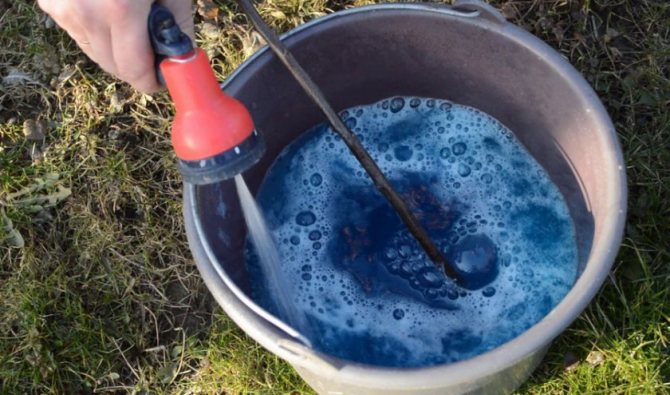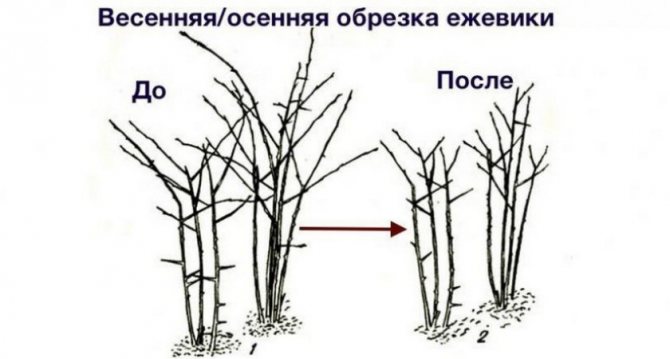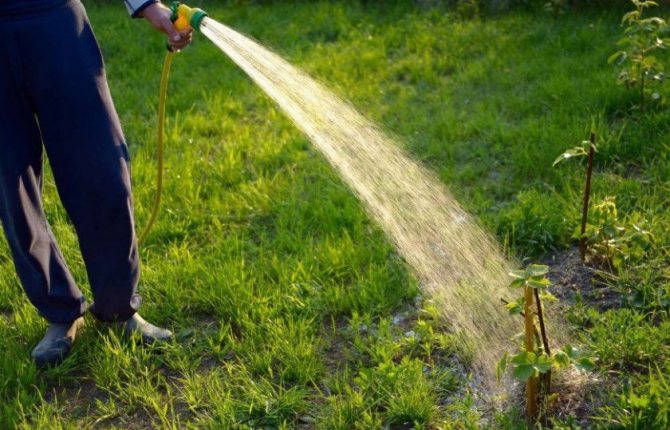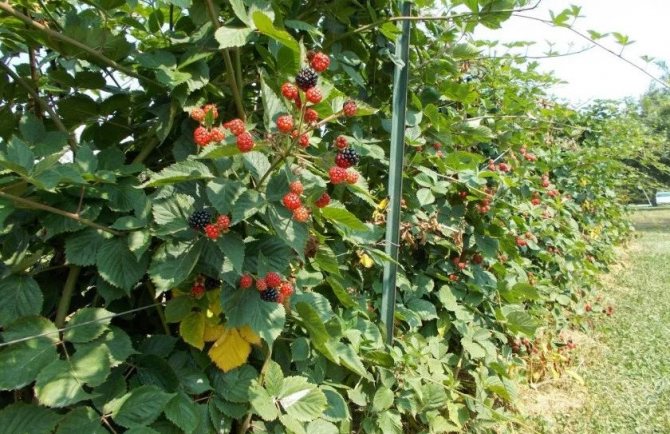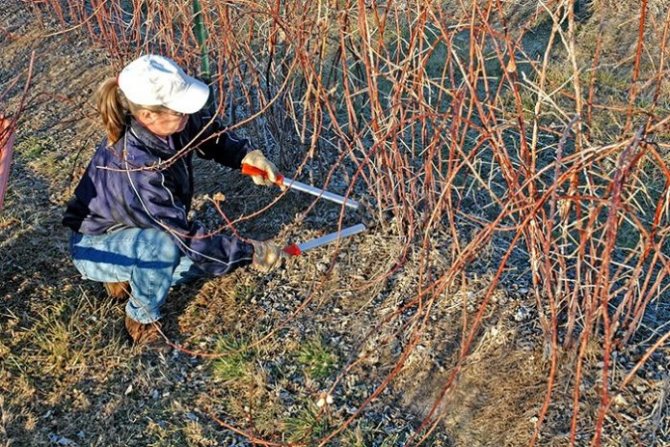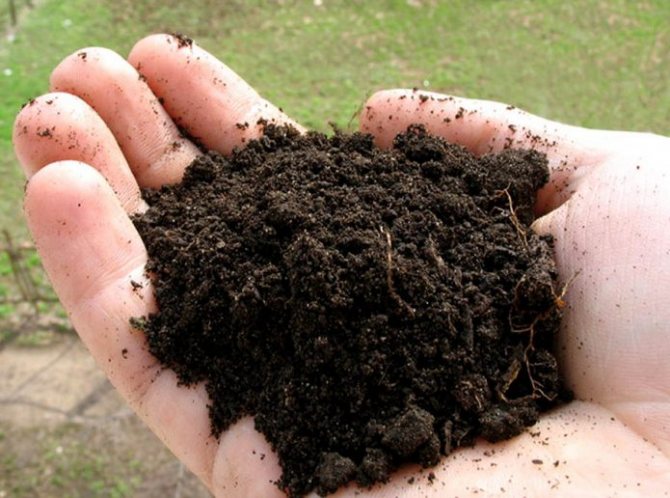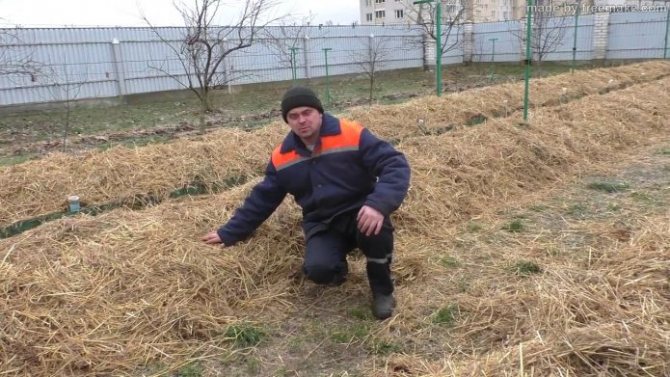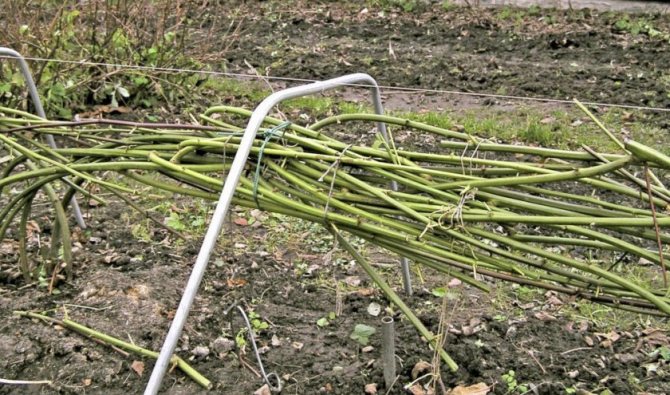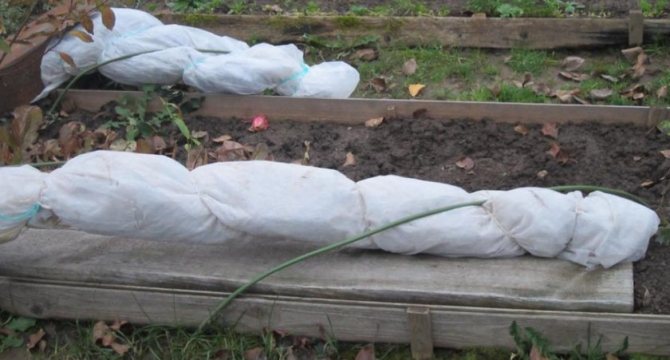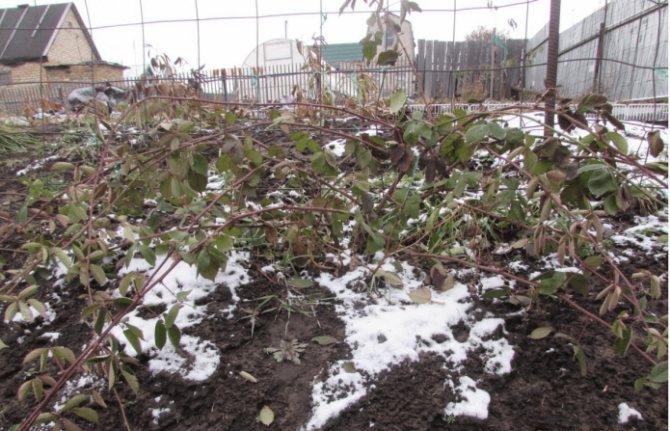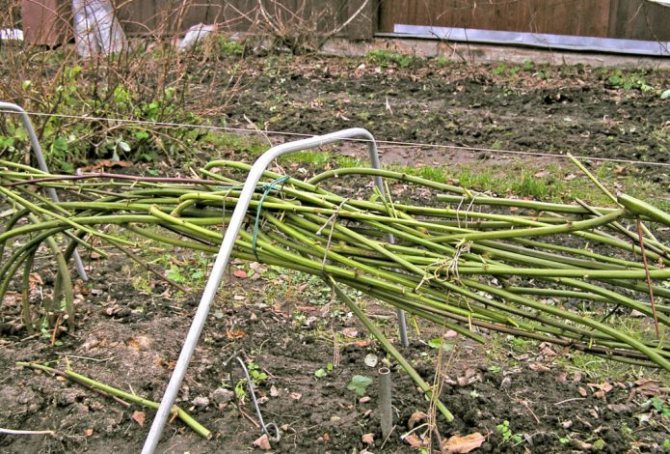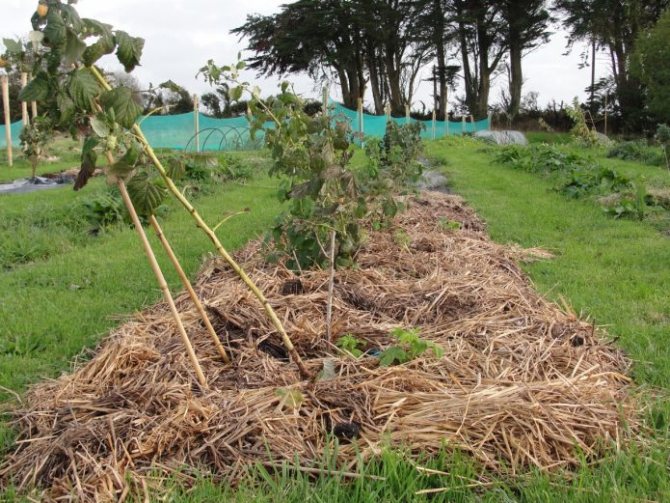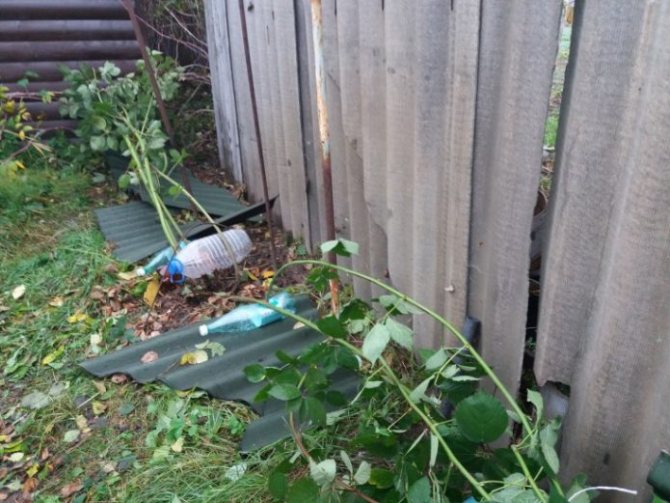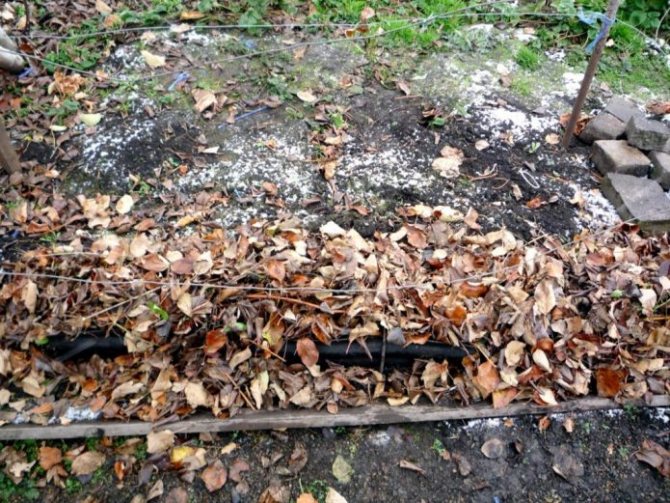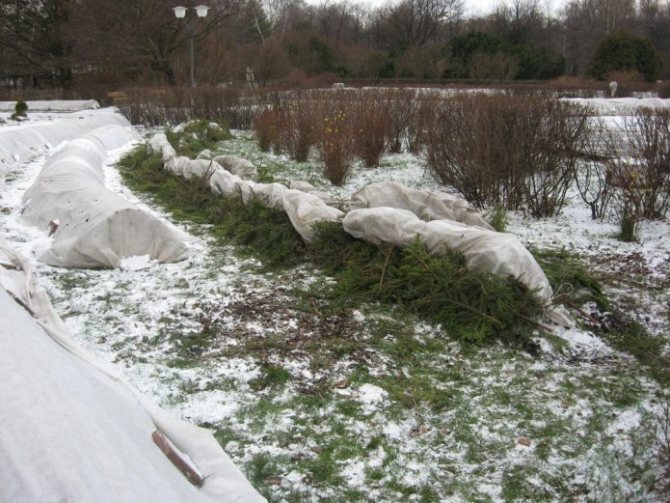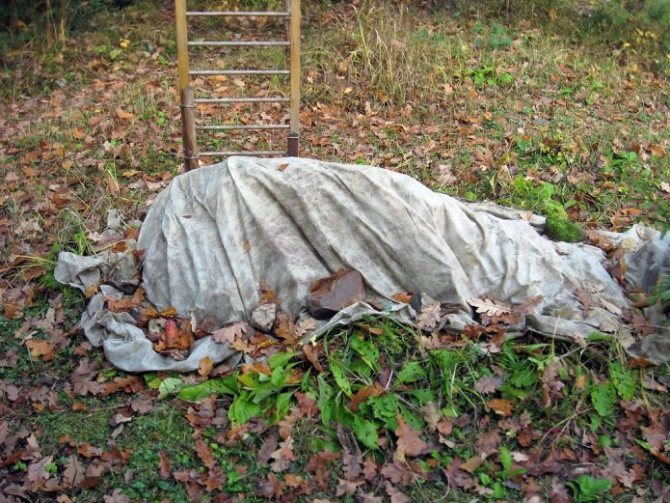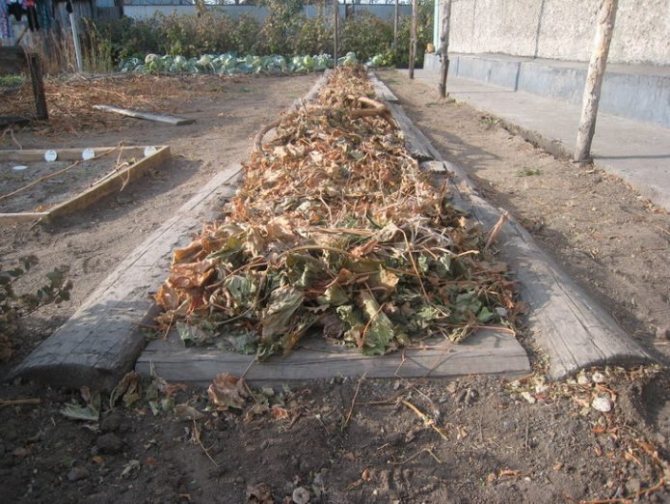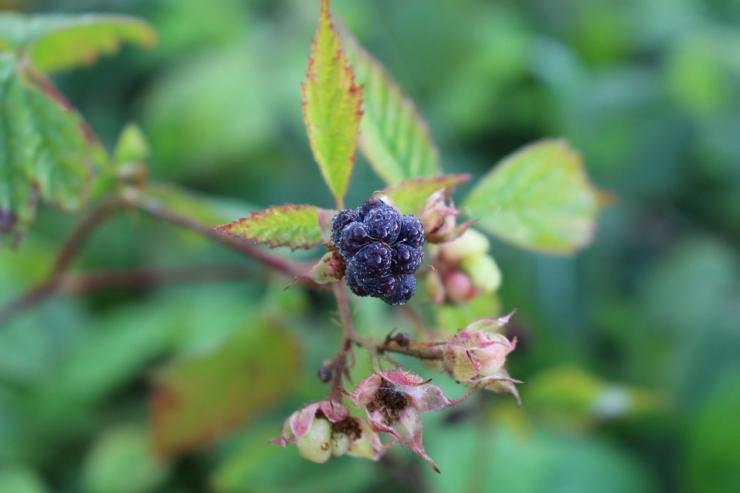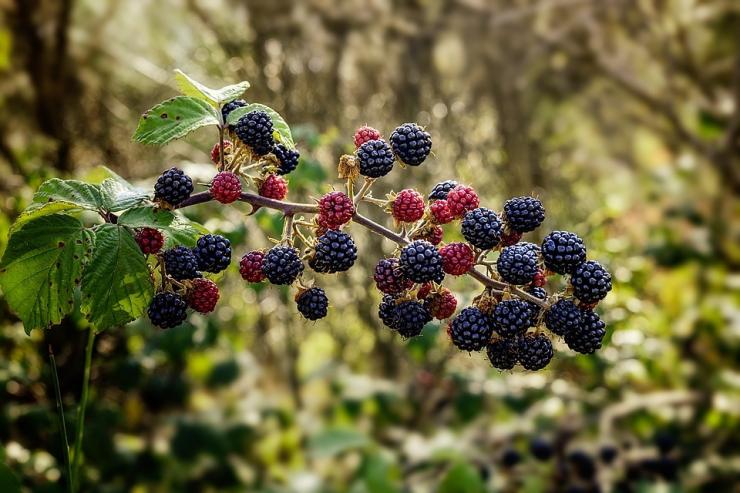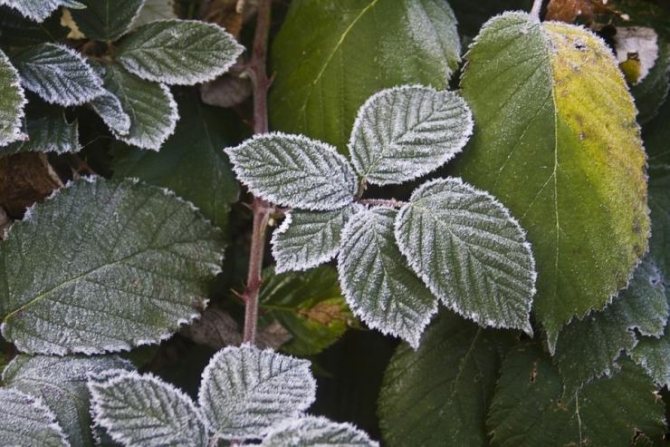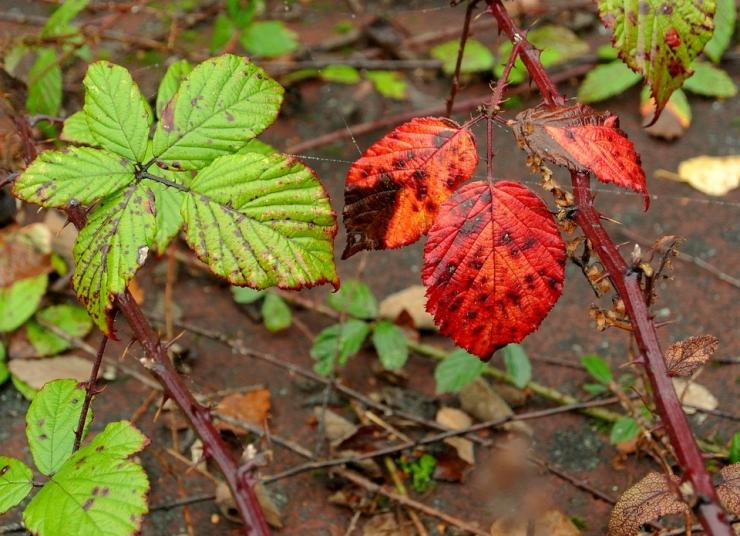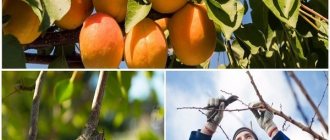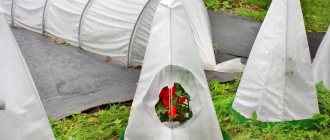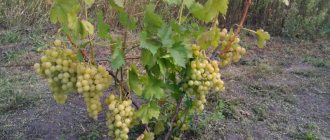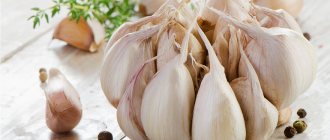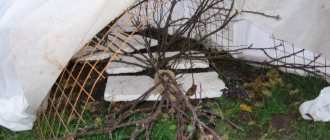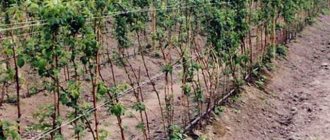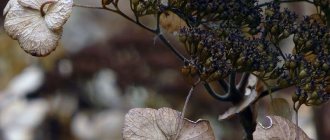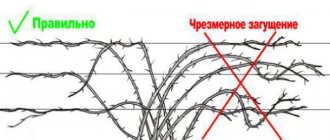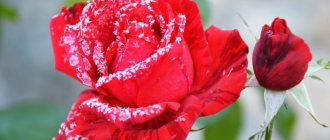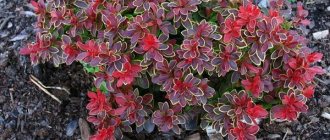Pre-hideout activities
Preparation for wintering begins with cleansing the garden of leaves, removing dry branches and weeds. Then they dig up the soil in order to destroy some of the hibernating pests. Blackberry bushes are pruned, sprayed for diseases with 1% Bordeaux liquid or another preparation based on copper (for diseases). And only after that they cover.
Cropping: step by step instructions
Check the tool before starting work. It must be well sharpened. The cutting edges are wiped with alcohol before pruning each subsequent plant. If any bush is infected with fungi or viruses, you will not transfer these microorganisms to healthy plants. Most varieties have thorns along the entire length of the shoots. Therefore, wear gloves.
Important! Pruning is always done after the first freeze. At this time, the sap flow stopped and the bush will suffer less from stress.
Trim Algorithm:
- Start trimming from the outside edge, gradually moving towards the center.
- It is safe for the plant to shorten the branches by about 1/3. This leaves room for them to grow and branch out next year.
- Remove dry stems at ground level without leaving any stumps. They can become a source of infection of the bush with fungi or pests.
- Leave only one of 2 shoots that are less than 5 cm apart. Otherwise, the bush will be too thick, which is good for pests, but bad for the health of the blackberry.
- Stems that will no longer bear fruit are also harvested. This will stimulate the spring growth of new ones.
Weeding, loosening
The purpose of loosening is to give oxygen access to the roots of the plant. It is necessary for the development of beneficial soil microorganisms, which are involved in the process of processing the minerals contained in the soil, thereby improving the nutrition of the bush. The loose texture also promotes root development - they grow better.
Autumn loosening is also carried out in order to destroy some of the pests, the larvae of which are prepared for wintering in the ground. You can loosen with a garden hoe or cultivator. Weeds will most likely not grow in late autumn. But if there is weed, be sure to remove it from the area on which the vines will be laid.
Watering and fertilizing
Considering that blackberries are a wild plant and there are not so many cultivated varieties of it, the agricultural technology of garden culture is not too different from forest culture. In summer, it is watered as the soil dries up. This shrub is hardy enough and will grow at any watering intensity. But the lack of moisture reduces the size of the berries and the yield, since the fruits are mainly composed of water. Podzimny watering of the plant is not required. The moisture that it receives with rainwater is enough.
Blackberries consume small amounts of nutrients. An abundance of fertilizer will stimulate the growth of shoots and leaves, but not fruit. Therefore, before fertilizing, look at the bush carefully. Powerful and tall shoots indicate that feeding is not needed. Under a weak bush, you need to add 100 g of superphosphate and 30 g of potash fertilizers without chlorine. Thoroughly water the soil around the plant to absorb them. Watering depth - 10 cm.
Some growers also apply 5 kg of compost for each plant. But it contains nitrogen in large quantities.He can activate the autumn growth of shoots, which is fraught with the weakening of the bush and the consumption of those nutrients that he needs in the spring. Therefore, other gardeners believe that it is better to introduce organic matter in early spring, with the beginning of sap flow.
Pruning blackberries in autumn
Before you start pruning a blackberry (and any plant), you should figure out which shoots it bears fruit and what is its life cycle. So:
- Blackberry is a shrub with a two-year development cycle that bears fruit on last year's shoots. In other words, after fruiting, you need to get rid of them, because They will no longer bear fruit and are not suitable for reproduction (You can propagate by rooting the tops of young shoots in August).
By the way! The site has a separate article about how to propagate blackberries: all ways.
- Accordingly, young shoots of the current year will bear fruit only the next, i.e. they must be preserved without fail, namely, sheltered for the winter so that they overwinter well and give a normal harvest in the next season.
Thus, pruning the blackberries after fruiting is necessary to give strength to the bush for the next year.
When to prune blackberries after fruiting (in autumn): optimal pruning times
Pruning blackberries should be done immediately after they finish fruiting, in other words, as soon as you collect all the berries (harvest), you can immediately begin to remove the sprouted shoots.
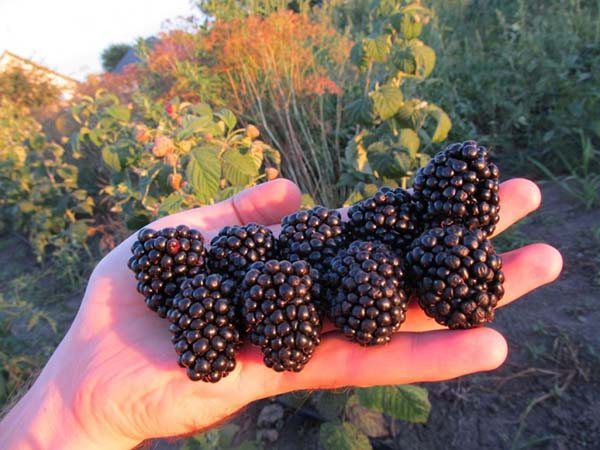
It is worth understanding! Most likely, you will say that the autumn pruning of blackberries is not at all autumnal, but summer. But, pruning after fruiting and / or in August is usually called "autumn", and not "summer".
Thus, the approximate timing of the autumn pruning of blackberries after fruiting is August - September (October - for late varieties), in the South - earlier, and in the Middle Lane (Moscow region) - later.
Why you should not postpone the pruning procedure until late autumn?
Everything is obvious: this is done so that the bush does not waste extra energy on feeding old unnecessary shoots, but sends them to a young growth so that it fully develops and is well prepared for winter.
Video: pruning blackberries in the fall
Pruning rules or what blackberry shoots can and cannot be cut in the fall
What branches of blackberries do you need cut off completely for autumn pruning:
Remove completely = cut at the root without leaving any stumps.
- all last year's (2-year-old) shoots that have borne fruit;
It is very easy to distinguish them from fresh ones (this year), because dried stalks, berries remain on them, and their leaves turn yellow and begin to fall off.
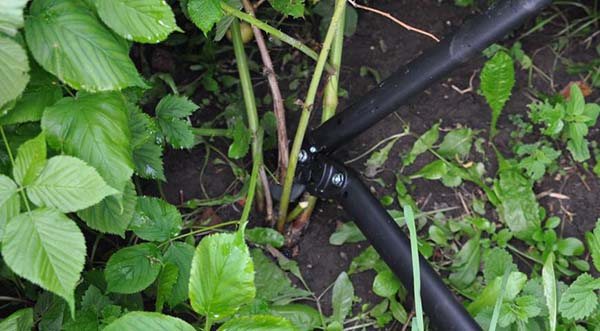

What branches cannot be cut during autumn pruning:
- young shoots of the current year;
- side shoots (stepchildren) on these young shoots.
Do not leave one main barrel as it is. blackberries also bear fruit well on stepchildren.
Which shoots should correct length:
- if over the summer the young branches of the current year have grown very much and have clearly become not along the length of your trellis, then they should be shortened by cutting to the required length (as a rule, they are left from 2 meters or more).
Interesting! Sometimes you can find a direct recommendation about pinching the tops of young shoots, which will stimulate their better branching (the formation of lateral shoots).
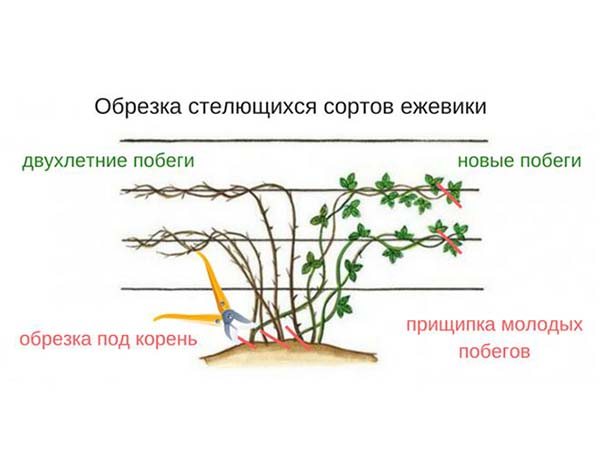

Important! If the volume and space of the trellises allows you to accommodate the entire growth, and the bushes are provided with a large nutritional area - they are planted at a distance of 3-3.5 m from each other, then you can not cut them, because in this case you will simply deprive yourself of part of a possible harvest.
However, if you are not ready to take good care of (regularly water, feed) such long bushes, then keep in mind that without good nutrition they simply will not be able to bear fruit normally.
Thermal insulation of a blackberry plot
Laying vines directly on the ground is not recommended.A layer of cardboard, spruce branches, straw, even just a board is placed under them. The stems are removed from the supports, tied with twine and placed on this ground cover layer.
In regions with severe winters, the shelter is always made multi-layered:
- laying between the ground and the plant: cardboard, board;
- then a layer of covering material follows: straw, spruce branches;
- then they put the vines;
- the final layer of the shelter: agrofibre, spruce branches, straw.
On top there may be a layer of polyethylene, fixed on a metal frame, like a mini-greenhouse. It is desirable that it must have holes for organizing air exchange.
Bending down
There are 2 types of vines: curly and erect. The former are easy to bend. To lay them, simply remove them from the trellis. Erect laying is more problematic. They break when bent. Therefore, after harvesting, they begin to train them, hanging them on each load. Under its weight, the vine will gradually tilt to the ground. After that, you can put her in a shelter for the winter.
What should be taken care of in the fall before shelter
In order for the blackberry to endure wintering more easily, before sheltering it is necessary:
- Continue watering the bushes after harvesting until the onset of cold weather, if the weather is dry.
- Thin the shoots by cutting off those that have already yielded, since they have served their time, as well as young branches. For 1 bush, 6 to 8 branches are enough. The remaining branches are shortened by about 20 cm.
- Weed, loosen the ground.
- Fertilize with potash fertilizers without chlorine - this will facilitate wintering.
- Sprinkle the soil with sunflower leaves or hulls to protect the roots and retain moisture.
- Remove the plant from the supports and gently press it to the ground. The closer to winter, the more brittle the bushes will be, so they need to be removed earlier. If the plant grows upright, you need to bend it down gradually, making the top heavier with some kind of weight.
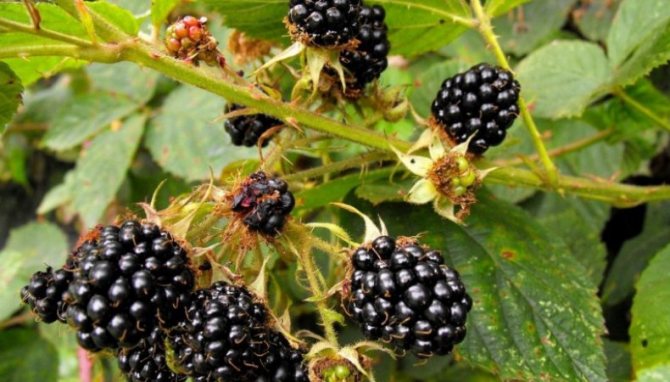

What to hide
Covering materials are divided into organic: straw, spruce branches, foliage, tops and industrial: spunbond, agrofibre. Each type has its own advantages and disadvantages.
Did you know? Blackberries have antiviral, antibacterial and anti-cancer properties due to their high levels of ellagic acid.
Agromaterials
Non-woven covering materials are made of synthetic fibers. They differ not only in the type of initial substance, but also in density. To protect the shrub from frost, choose a density of 17-50 g / m².
The advantage of such synthetic fabrics is that they are air permeable. Condensation does not form under them. Pests and rodents attacking organic shelters are indifferent to them. For winter shelters, the non-woven covering material can be rolled up in several layers.
Important! Give preference to white materials, they reflect sunlight better. This means that the air in the shelter will not warm up too quickly.
Improvised means
The means at hand include everything that is in the country "here and now".
This could be:
- the soil;
- hay;
- vegetable tops;
- leaves.
Natural
Most of the materials at hand are natural. They are derived from plants. After the processing of grain crops, rice husks, crushed corn cobs, and straw remain. The woodworking industry is a source of wood chips and sawdust. From the forest, you can collect spruce branches or peat, and from the home garden of leaves, plant tops, herbs.
Not all materials are worth using. Leaves or tops can be a source of disease. And hay is also a potential source of weeds. In addition, blackberry bushes are equipped with thorns. In order not to waste time on removing hay or tops from them, use something that is easy to place and then remove, for example, spruce branches. And also with those materials that will be safe for your garden: straw, wood chips, buckwheat husks or seeds.
Synthetic
All nonwoven films are of synthetic origin. They are made from polypropylene fiber. Spandond is one of the best bush shelter materials, but not the only one. There are a number of agro-fabrics that can be used for the same purpose: agril, agrospan, agrotex.
Spunbond is available in black and white. White is used for stretch shelters, black - for soil mulching. Weeds do not grow under it. And it preserves well covered plants during wintering. The material is considered the best in terms of price and quality ratio. Its properties: it passes moisture and air well, condensation does not form under it, the rays of the sun pass through it well and it can withstand frosts down to -50 ° С. To create a good microclimate for the bushes, it is recommended to stretch the material over the frame. They can simply wrap up erect shoots.
Find out when to shoot the blackberry winter hideaway. Plain plastic sheeting is also suitable for shelter construction. The main thing is to choose one so that it can withstand gusts of wind and snowfall. Its density should be around 42-60 g / m². You can cover the bushes with reinforced film. It is denser, withstands any wind and will last for several seasons. In case of mechanical damage, the size of the hole on it will be limited by the cell, or rather by the reinforcing material that creates the boundaries of the cells. But its cost will be higher than that of conventional film.
Another synthetic material is geotextile. It is also made from polymer fibers. Can perfectly protect bushes from frost. Due to its good carrying capacity, the vines under it do not damp, and mold does not form in the shelter. The method of its application does not differ from that of the spunbond.
Another covering material is lutrasil. They cover greenhouses and use it to protect bushes from frost. The recommended density of lutrasil is 50-60 g / m². It performs all the same functions as spunbond, but is more exposed to ultraviolet radiation and will last a gardener only a couple of years. Its indisputable advantage is its relatively low cost.
Ways and features of sheltering blackberry bushes
All the bushes are covered according to the same scheme: they disinfect the vines with Bordeaux liquid, remove the leaves from the area where the branches are laid, make a gasket that will protect the blackberries from contact with the soil. This is a mandatory step as the vines can root by contacting the soil. Then they wrap the bush with agromaterial and bend it to the gasket. For regions with cold winters, a layer of spruce branches is laid on top of the fixed blackberry shoots. You can replace pine branches by installing a frame and pulling a covering material over it.
Video: Blackberry shelter for the winter
Erect bushes, the vines of which cannot be bent to the ground, are wrapped in foil. If there is a likelihood of severe frosts, then gardeners install a metal mesh around the plant, fill it with foliage or straw. In fact, this is the same shelter as on the ground, only installed vertically. The difference from the previous design is that it is intended for upright shoots.
No thorns
Any type of cover material is suitable for plants without thorns. The vines are removed from the support, a layer of straw is laid under them, bent down, fixed and covered with agrofibre or spruce branches on top.
Learn how to properly plant and grow thornless blackberries.
In the first year
The bushes of the first year of growth can be covered with straw mats. A multi-layer cover made of spruce and spunbond is also suitable. It is not recommended to use materials that will cling to the spikes. For example, hay, tops, leaves, and you can also pack the argofiber-wrapped plant in a styrofoam box. This design best protects the blackberries from frost.
Covering instructions:
- Wrap the bush with agrofibre.
- Set a grid around its circumference. The diameter of the structure is about 50 cm.
- Fill the mesh with straw. It will serve as insulation for the bush.
Young bush
The plant is tied in a bundle and wrapped in spunbond. It can also be bent to the ground like this. Be sure to mulch the soil in the root zone to keep the roots from freezing.
Did you know? Blackberries, like most berries, are very rich in antioxidants, fiber, and a number of other health-promoting nutrients. For example, vitamin C in it is 35% of the daily value.
Bush shelter algorithm:
- Remove the branches from the mountings.
- Twist them into a bundle, but not too tightly.
- Wrap with agrofiber.
- Bend it down, laying it on cardboard, spruce branches or a board board.
- An upright shrub is not laid, but the bush is fixed in agrofibre with a net, in the middle of which straw is laid as a heater.
Old bush
Old bushes have a developed root system and do not need overwintering. Erect blackberry varieties are more resistant to frost. Therefore, they also do not need a thorough hiding place. But if you are not sure that your plants will safely tolerate a drop in temperature and the buds will not die, use a horizontal or vertical winter shelter.
It is recommended to use structures covering the blackberry, if thaws in the region are often replaced by frosts in winter. The moisture formed on the kidneys at the time of the thaw, when the temperature drops, turns it into ice and breaks it. In this case, it doesn't matter how low the thermometer goes down.
Instructions for hiding an old bush:
- After stable negative temperatures are established, the root zone is covered with mulch. The thickness of the layer is about 10 cm. It will protect the roots from temperature changes and damage during a sharp change in temperature.
- The branches are disconnected from the trellis.
- Wrap it up with spunbond and bend it to a layer of mulch.
How can you cover a blackberry for the winter
For shelter, you can use improvised or purchased materials.
Check out the rules for sheltering grapes, roses, apple trees, weigelas, hydrangeas, figs, lilies, thuja and raspberries for the winter.
Materials at hand
Suitable materials for shelter are:
- Soil - this type is time consuming but has a good effect. The disadvantages include difficulties in removing this type of shelter in the spring - thorns can scratch hands, and the remains of soil on the tops of the bushes cause increased growth of lateral shoots.
- Snow - in a snowy winter, it will reliably protect the plant, however, in the event of a thaw, it can be a dangerous source of excess moisture, which, when cold weather sets in, will freeze and damage the plant.
- Vegetable tops - dried and healthy are used, which are harvested in the process of harvesting vegetables.
- Hay and straw are both easy to use and easy to remove in spring. Of the minuses, such a shelter can attract mice for the winter, which will willingly eat blackberry bushes.
- Fallen leaves of trees - this species is characterized by low labor intensity, but here it is important not to cover with foliage from fruit and berry trees, since pest larvae can be transmitted with it.
- Corn leaves - this material is characterized by rigidity, so it can protect the shrub well, it also does not absorb water well. Leaves are dried after harvesting corn or used naturally dried, laid in a thick layer. Keep the leaves healthy and free from damage.
- Sawdust and shavings - it is not recommended to use it due to the fact that they reduce the nitrogen content, acidify the soil, strongly absorb water, which then freezes into an ice block, and contribute to the reproduction of pests.
- Peat is characterized by a high degree of moisture absorption, therefore it is poorly suited.
- Branches of coniferous trees - a thick layer of this shelter allows the shrub to breathe, retains heat well, and repels rodents and pests.
- Hulls of sunflower, buckwheat, rice - the material is good because it does not absorb water well, but it will take a lot to cover it.
The positive side of using scrap materials is the absence of financial costs, the negative side is the impossibility of using them on large areas. Did you know? In England, there is a legend that blackberries can only be harvested until October 11 - on this day the devil spits on it, and people who eat the berries picked after that date become unclean.
Synthetic materials
You can cover blackberries using synthetic materials purchased in the store:
- The film - its thick layer will serve as a good cover during a snowy winter, but can create problems if a thaw comes. In this case, a lot of moisture and heat forms under it, which will lead to decay. Snow-free winters are dangerous, in this case there is a greenhouse effect, which is created on a frosty day by the sun and forms a high temperature under the film. After sunset, a drop in temperature leads to frostbite. Alternatively, you can put paper under the film or sprinkle it with sawdust on top.
- Roofing material, pieces of old linoleum - the ease of use of this type of shelter resists fragility during frost.
- Felt or synthetic winterizer - this type is suitable only for northern latitudes, where there are snowy and frosty winters, since during a thaw the material can pick up moisture, and blackberries will rot.
- Burlap - used as an additional covering material in conjunction with improvised shelter.
- Non-woven material (spunbond, agrotex, lutrasil, agrospan) - the advantage of this type of material is good frost protection and the ability to pass air. It does not create a greenhouse effect, so you can cover it before the frost begins, and remove it long after it ends.
- Polyfoam - protects well, but is expensive and easily gnawed by mice.
Did you know? Polyfoam is 98% air. These types of shelters can protect large areas of planted berries, they can be used several times, but they require some financial investment.
When to start preparing?
- apply top dressing in a timely manner; - water regularly; - remove excess growth; - destroy weeds; - loosen the soil under the bushes, if it is not mulched; - tie up the shoots on supports.
No matter how unpretentious the blackberry may be, preparation for winter is mandatory for it, since even domestic cultivars cannot boast of high frost resistance, and even more American ones. Unlike remontant raspberries, blackberries bear fruit only on last year's shoots, and if the above-ground part of the bush freezes, you will simply be left without a crop in the coming season.
It's no secret that harsh winters are best tolerated by healthy, strong plants. For this reason, at the very beginning of the season, one should ask the question of how to prepare blackberries for winter?
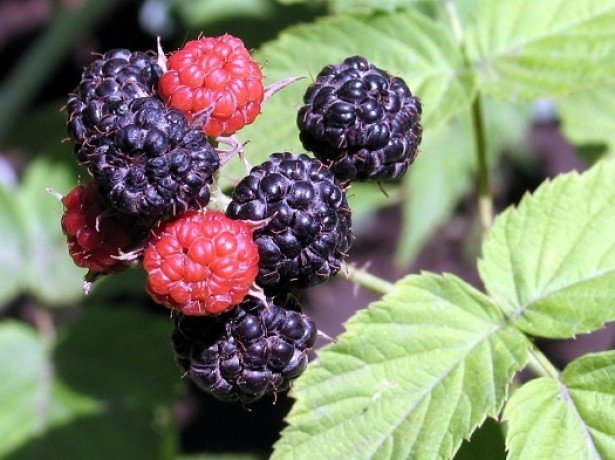

In the photo there are blackberries
First of all, you need to pay attention to the proper care of blackberry bushes. It includes:
- regular watering,
- thinning bushes,
- removal of young growth,
- garter of shoots to the support,
- formation of bushes,
- weed control and soil loosening.
Video about the cultivation and care of the Thornfree variety bushless garden blackberry
Timely feeding plays a significant role. So, during the intensive growth of shoots, ammonium nitrate is introduced into the soil (for each square meter, 20 g). In the fall, the bushes are fed with potash fertilizers that do not contain chlorine (30 g per plant) and superphosphate (about 100 g per bush), add at least 6 kg of compost or humus and dig up the ground with a pitchfork to a depth of 10 cm.
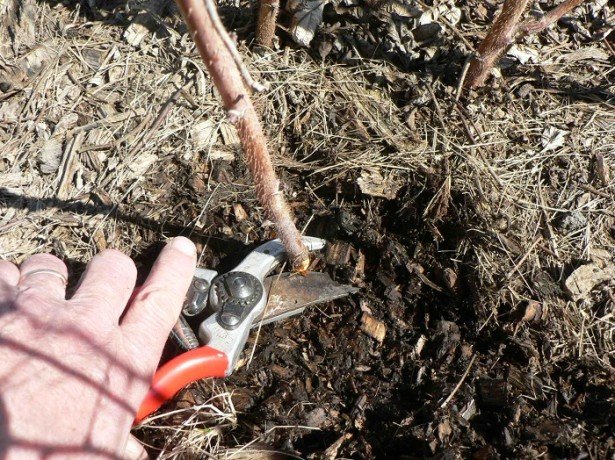

In the photo, pruning blackberries
You will need to remove all biennial shoots that have borne fruit and remove excess young branches that can lead to thickening of the bush (you will find many useful tips on this topic in the article on pruning raspberries).It is also recommended to pinch the crown of the annual stems so that the plants do not stretch in height, but more forces are directed to the development of lateral processes.
We suggest you familiarize yourself with: Storing carrots in sawdust for the winter
After finishing pruning blackberries, do not forget to immediately remove all cut shoots along with the rest of the plant debris and burn them to prevent the spread of diseases and pests in your area. After removing the debris, sprinkle the ground under the blackberry with sawdust or peat - this will protect the roots from frost and help keep moisture in the soil for a long time.
How to hide
After the end of the preparatory measures, the blackberries are pressed as close as possible to the mulched soil, trying not to damage the fragile branches. If it is not possible to bend the bushes, they are covered with boxes made of plywood, slate. To prevent the film or non-woven materials from freezing to the plant, a layer of mulch from scrap materials is poured under them or a frame is built that will not allow materials to come into contact with branches and leaves.
Learn how to choose the right covering material and what agrospan and agrotex are.
Non-woven fabric can be black and white, the only difference between them is that white reflects the sun's rays better and is suitable for snowless winters. It also happens of different densities: material with a density of 100 g per 1 sq. m can be stacked in 1 layer, 50 g per 1 sq. m - in 2 layers. It is often recommended to cover with 2 layers of a thinner version. When choosing the width of the material, you should stop at 1.6 m.
Important! You do not need to try to wrap the shrub in a covering material, as in a diaper, the warmed soil gives off heat, and not the flooring, so try to cover more area around the plant. The edges of the flooring must be pressed to the ground with something heavy (stones or sprinkled with earth) so as not to be blown away by the wind. It is recommended to put a layer of snow on top of the flooring to keep more heat.
Frost resistance characterizes the ability of blackberries to withstand low temperatures. However, the fact that the plant will survive does not mean that it will not suffer - in winters with little snow, the buds and tips of the shoots may freeze, as a result the harvest will be poor. The most famous of the frost-resistant varieties is Agava, which can withstand more than -20 ° C. But young branches of this variety can freeze in such frost. Although new shoots will grow in their place in the spring, they will not give a harvest this year. Based on the foregoing, frost-resistant blackberry varieties also need shelter, otherwise a weakened plant will not delight you with berries.
Frost-resistant varieties - to cover or not?
Among different types of plants, there are thermophilic and frost-resistant varieties, blackberry is no exception. In this regard, the question arises: is it necessary to wrap up frost-resistant varieties of blackberries in the same way for the winter period, or can you not worry about them in frosts?
If the description of the variety indicates that it is frost-resistant, this only means that it will not die in winter without shelter. But the shoots may well partially freeze out, which means that you can not dream of a rich harvest.
The second example is in the cold regions of our country, where winters are consistently harsh, only frost-resistant varieties of blackberries are recommended for planting, because they will be able to endure such a winter with a timely and well-arranged shelter - no variety will survive there without shelter.
So preparation of blackberries for winter is necessary, any varieties should be covered, this is the only way to count on a good harvest.
The most famous frost-resistant varieties include Agave, Giganta and Black Thornless. They are capable of withstanding frosts down to -18 ... -20 degrees without shelter without significant consequences. However, any experienced gardener will advise you not to experiment and provide the blackberries with shelter in time.This grateful plant always responds to care and good care, so with a little effort, you can enjoy delicious and healthy berries every year.
Testimonials
The film is good where, in addition to the film, there is also snow lying on top of it. If there is no snow, then a greenhouse is obtained (the plant continues its vegetation and vomits out at a sharp temperature drop). On sandy loams, the film can be covered from above with a layer of earth 3-4 cm (for 300 bushes it is not very time-consuming, 3-4 people-day of work). Such a shelter is more reliable. Breathable spunbond type nonwovens on blackberry are used. The density can be different, but it is better to use 2 layers with a density of 50g / m2 than one with a density of 100g / m2. m. The cost of the shelter is quite comparable to the greenhouse film, and the process itself is the least time consuming). A synthetic winterizer is also used, but usually for sheltering a school or a cuticle. The synthetic winterizer will cost more, it is highly saturated with moisture, is not strong enough and is heavy when wet, - not an option. Spunbond is quite durable (enough for a certain number of seasons), lightweight, well rolled out and rolled into a roll (to cover a large number of bushes, it is more convenient to use 3 people - one puts, two unwind the roll, then the edges of the material are pressed down with boards or sprinkled with soil). No arcs and frame are required, with the correct formation of replacement shoots under the shelter, the material is simply rolled out in a path. It depends on your geographic place of residence, or rather on the climate. If the winters are not too harsh, then you don't need to cover. Although experienced gardeners say that blackberries covered in winter give a greater yield. You can recommend this article to your friends! Help 57 times already
Garden blackberries are an unfortunate guest of Russian sites located in the cold regions of the country. The reason for this is the average winter hardiness of the culture. If you know some of the tricks in organizing winter protection for blackberries, you can grow this berry even in areas with severe winters - in the Urals, in Siberia.
When to cover, at what temperature
The optimal timing for wrapping blackberries depends not only on its specific variety and type, but also on the region in which the site is located. It is recommended to start work when the air temperature at the site is established within the range of -5 ... -70C.
In the suburbs, Central lane
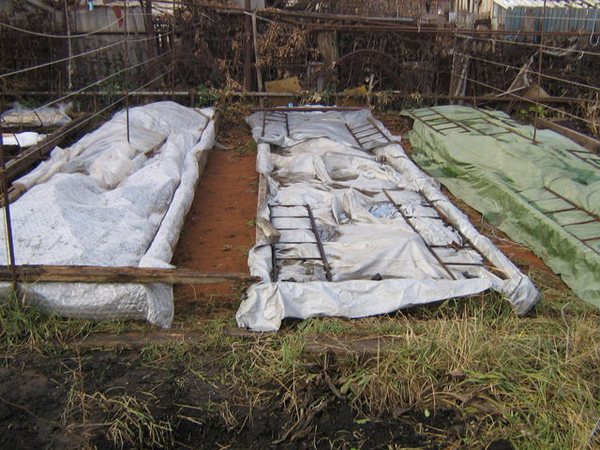

Winters in Central Russia cannot be called very cold, but this area is characterized by sharp temperature drops and strong short-term frosts, which blackberries are so afraid of. The amount of snow may also be insufficient for the natural shelter of the bushes, therefore, gardeners of the Moscow Region and the Middle Strip have to carefully cover the plants. Tentatively, work will begin in mid-November, based on weather reports.
How to cover a blackberry for the winter: video
In the Urals
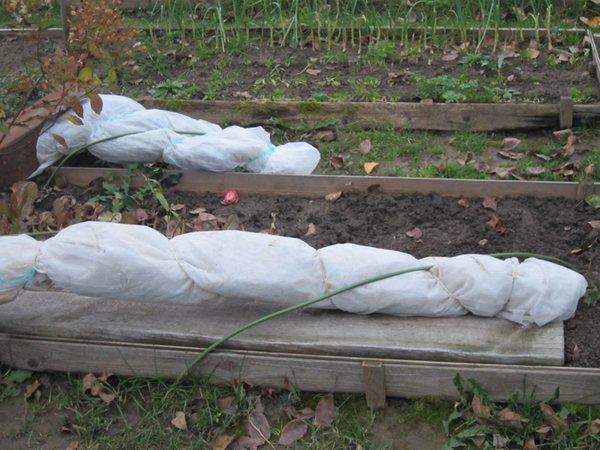

The Ural winters are some of the harshest in the country, but they do not prevent gardeners from growing this berry crop on their plots. Even the most winter-hardy varieties of blackberries in the Urals have to be thoroughly covered. Taking into account the weather, they begin to wrap up the bushes in the second half of October.
In Siberia
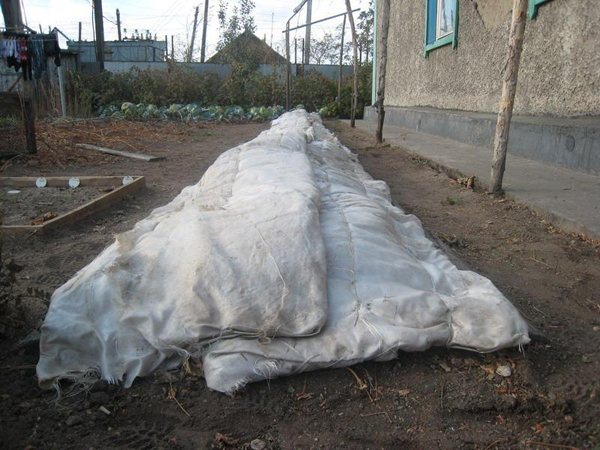

The short Siberian autumn and the rapidly approaching winter force summer residents to shelter blackberries already in mid-October. In order for the culture to survive the long cold winter, it is carefully sheltered by organizing capital multi-layer shelters.
In the Leningrad region
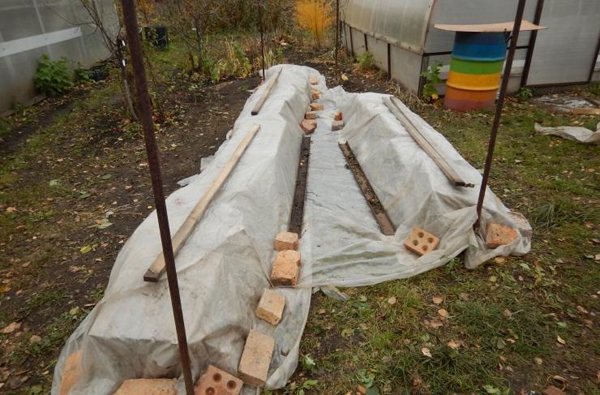

Despite the fact that in the Leningrad region winters are mild and snowy, the real problem in wrapping blackberries for the winter is the high air humidity in the region. If you cover too early, and / or remove the protection too late, the bushes will undermine and start to hurt. And if the under-warmed shoots can be cut out during spring pruning, then as a result of the under-warming of the roots, the bushes may die.Therefore, in November, you need to closely monitor the weather reports and try to determine the most suitable date for this event.
Winter hardy varieties of blackberries
With regard to resistance to cold weather, there are two concepts - frost resistance and winter hardiness. The first indicator indicates the minimum temperature that the plant can withstand. Winter hardiness implies an integrated approach to the issue - after all, not only frosts are dangerous for shoots, but also abrupt changes in temperature and humidity.
Nevertheless, blackberries for the winter can remain without shelter, especially if there is usually a lot of snow. The most popular varieties that can winter without additional insulation:
- "Agavam". This is an American variety that can withstand temperatures as low as -40 ° C and begins to ripen in early autumn. Shoots bear fruit in the second year, after which they die, but the underground part is perennial. Stems are thick, high, with large thorns. The bush can yield up to 10 kg per year. The berries are tasty, well kept.
- Gazda. This is an early variety, the berries ripen from the beginning of August. They are dense, sweet and sour, perfectly stored, suitable for transportation. The variety is frost-resistant, resistant to pests and diseases, with straight stems and small thorns, shoots bear fruit in the second year. After that, they need to be cut off.
- Darrow. It is a non-covering, frost-resistant perennial variety. Shoots are tall and prickly. Fruits up to ten years without a transplant, every year it gives more berries, requires a lot of light.
- Polar. Polish variety with aromatic sweet berries that are well stored and tolerated. Begins to bear fruit earlier than "Gazda" - from the end of June, withstands frosts down to -30 ° C.
- Chester Thornless. Besshorny blackberry with sweet and sour berries, can withstand temperatures up to -30 ° C. A strong root system protects against drought, and late flowering - from spring frosts.
- "German non-concealing". A frost-resistant variety with a high yield and relatively short stems. The berries are large and firm.
Preparing blackberries for shelter
By the time the blackberry is wrapped, its bushes must be fully prepared for the dormant period. In addition to the natural preparation that the plants carry out on their own, they will need the help of a gardener. In the fall, blackberries are fertilized, watered, shaped and treated against pests and diseases.
Top dressing
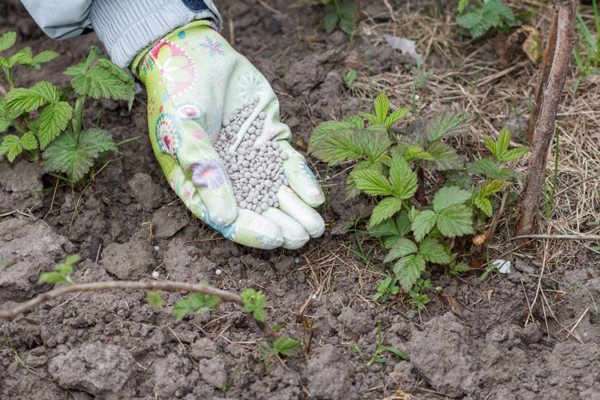

Potassium-phosphorus fertilizers are applied in August. It is these elements that will help the blackberry prepare for wintering. With the intake of phosphorus and calcium in sufficient quantities, the shoots ripen quickly, which increases the winter hardiness of the whole plant. Fertilizers can be mineral or organic, blackberries respond equally well to them. Before feeding, the blackberry is watered abundantly.
Pruning
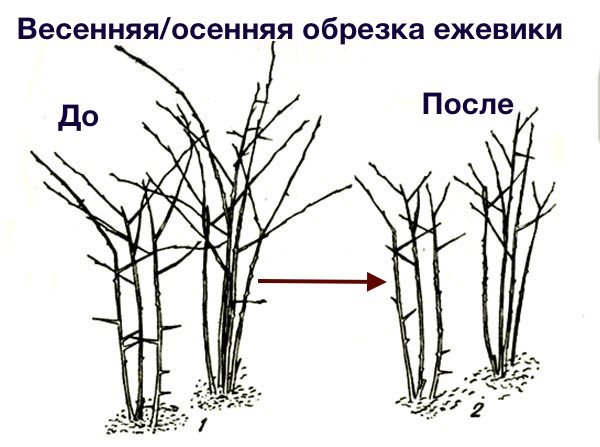

Pruning blackberries in the fall greatly simplifies the care and treatment of pests. This operation must be carried out no later than 3 weeks before the onset of frost. During this time, all the wounds inflicted have time to heal, so they will not affect the level of winter hardiness of the bush.
First, they carry out sanitary pruning - all old, fruiting shoots, dry and broken, damaged branches are removed. At the same time, they are cut into a ring, without leaving hemp. Then, the shoots are rationed - they leave from 4 to 11, depending on the variety, in the same amount, possible losses after wintering are taken into account. All other unnecessary weak branches must be removed. The next stage is to shorten the remaining shoots by 7 cm.
All plant residues and debris must be collected from the area of the trunk circle of the bush and burned.
How to trim blackberries: video
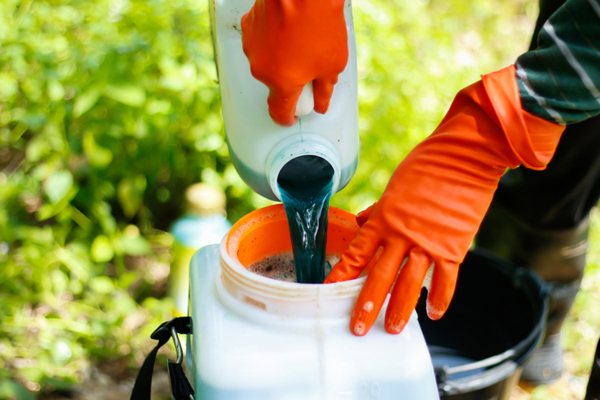

For preventive purposes, a 1% solution of Bordeaux liquid is used to treat blackberry bushes. It is sprayed over the entire surface of the shrub, abundantly wetting each branch.In order for the fight against pests and pathogens to be more effective, it is necessary to dig up the soil in the near-stem circle - pests that find themselves without shelter die as a result.
Blackberry care in autumn
Autumn care for this fruit-berry crop is very important, since it is the neat and prepared blackberry bushes that tolerate the winter period well under cover. The main activities that need to be done in the fall are pruning, feeding and preventive treatment against pests and diseases.
Pruning
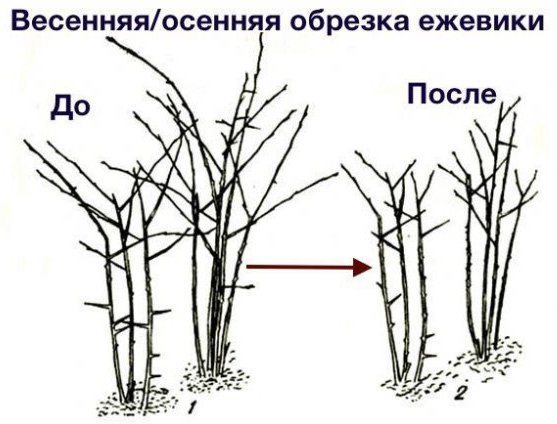

Blackberry pruning is carried out twice a season: in spring and autumn. The most suitable period for the main formation and cleaning of the shrub is autumn, and in the spring they only correct their results until the buds awaken.
First of all, sanitary pruning is carried out in the fall. It consists in removing all dry, broken, damaged and deformed shoots. They must be cut into a ring, that is, without leaving any stumps. Hemp is a cozy place for wintering pests and pathogens of various diseases. Here, they get rid of all the old (fruiting in the season) branches that will no longer yield the next year.
Further, at the bush, the number of remaining shoots is normalized (from 4 to 11, depending on the variety), only the strongest, thickest and strongest are chosen. All the rest are cut out. The tops of the remaining branches are shortened, which do not have time to ripen by the time of cold weather, by 7 ... 10 cm.
Thus, the autumn pruning of the blackberry bush will help bring it into a presentable decorative look, increase the yield in the next season, increase winter hardiness and protect it from the effects of overwintered pests.
How to trim and prepare blackberries for winter: video
Top dressing
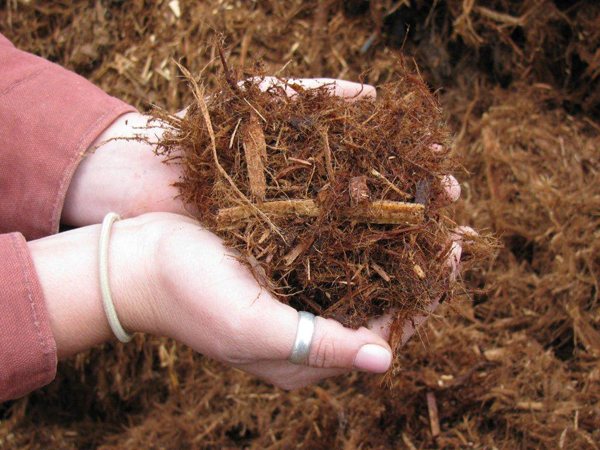

There is one interesting feature that you need to know before fertilizing a blackberry bush: first, it is plentifully watered, after which any top dressing is applied. In the autumn period, blackberries respond well to the introduction of both organic matter and mineral fertilizers.
Under one bush add 6 kg of humus (can be replaced with compost), 100 g of superphosphate and 30 ... 40 g of any potassium fertilizer, which does not include chlorine, for example, potassium sulfate, potassium magnesium. This mixture is carefully sealed with a pitchfork into the blackberry peri-stem circle to a depth of about 10 cm.
Treatment against pests and diseases
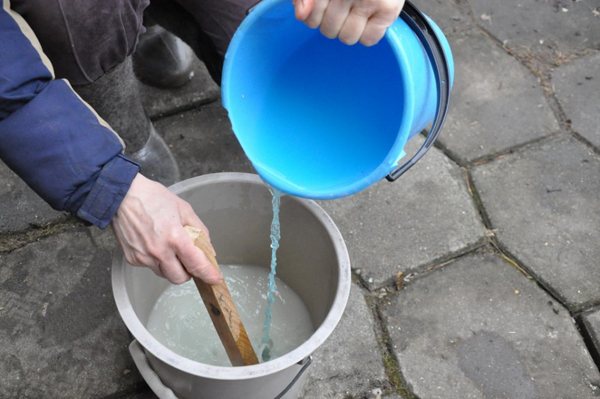

As a prevention of the appearance of fungal diseases for blackberries, a 1% solution of Bordeaux liquid is used. It is distributed over the shoots and the surface of the periosteal circle only after the foliage has fallen off. In order to destroy most of the pests of blackberries, it is enough to dig up the near-stem circle of the bush. Finding themselves without shelter, the pests die.
If during the season severe damage by pests or fungi was noticed, more drastic measures must be taken - to treat the plantings of blackberries with insecticides or strong fungicides. Processing is carried out after harvesting and removing damaged parts.
How to cover blackberries
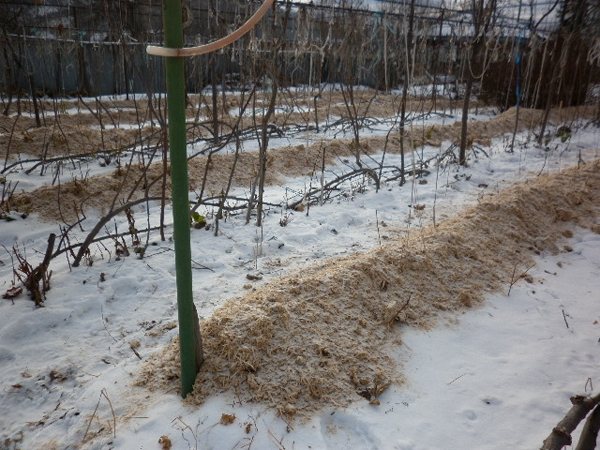

Various materials are used to organize a blackberry shelter.
To mulch the trunk circle of the bush and protect the root system, choose a mulch that does not acidify and does not lye the soil. The fact is that blackberries prefers to grow on soils, the pH level of which is in the range of 5.7 ... 6.5. In this regard, fresh sawdust is not used as mulch.
Rotted sawdust has completely different properties - it does not absorb excess moisture when snow melts, does not contribute to the loss of nitrogen and soil acidification. It is easy to prepare them: it is enough to mix them with urea and stand under a film for 2 weeks. In addition to rotted sawdust, buckwheat, sunflower husks, corn leaves are suitable as a mulching material.
The covering material that will separate the insulation from the blackberry shoots must be breathable. Here they use white agrofiber: lutrasil, spunbond, which will not let the plants suffocate and will allow air to pass through, which is necessary even during the dormant period.
Absolutely any material can serve as insulation: fallen leaves, spruce branches, corn leaves, etc. The main thing is that the insulation is separated from the surface of the blackberry shoots with a layer of agrofibre.
The film can only be used in the uppermost layer of the cover. The film structure should provide for vent holes through which air will flow to the bush. These openings should only be closed during the most severe frosts.
For shelter, boxes are often used, boxes made of a variety of materials - wood, foam.
How to properly cover the garden blackberry from frost


In order for the shelter to perform its protective function, it must be properly installed. Below is a step-by-step instruction for wrapping up garden blackberries for the colder regions of the country.
- In the near-stem circle, in the places where the branches of the blackberry, removed from the support, will be laid, boards are laid out. This will ensure that the branches do not contact the ground.
- Blackberry branches need to be collected in bunches and bandaged. If the bush is large, several sheaves are formed on it. Twine is used for tying.
- Bending down shoots is a very responsible occupation that requires accuracy and care. To prevent the shoots from breaking at the base as a result of the application of force, they are bent over the knee. Bunches of shoots are laid in the opposite direction from the center of the bush. If the erect blackberry does not lend itself to bending in any way, it is covered with boxes, slate, etc.
- The bent beams can be fixed in different ways: they can be tied together (if there are several bushes) or fixed to a support. The optimum height of bent shoots should not exceed 50 cm.
- The laid branches are covered with a thick layer of mulch, after which they stretch the agrofibre, cover the blackberries on top and fix them around the perimeter with loads: earth, stones, bricks or even plastic bottles with water.
- Insulation is laid on top of the covering material. You can do without it by wrapping the blackberries in a double layer of agrofibre.
- The last layer is applied with a film and fixed around the perimeter. Vent holes must be open.
Tips from seasoned gardeners
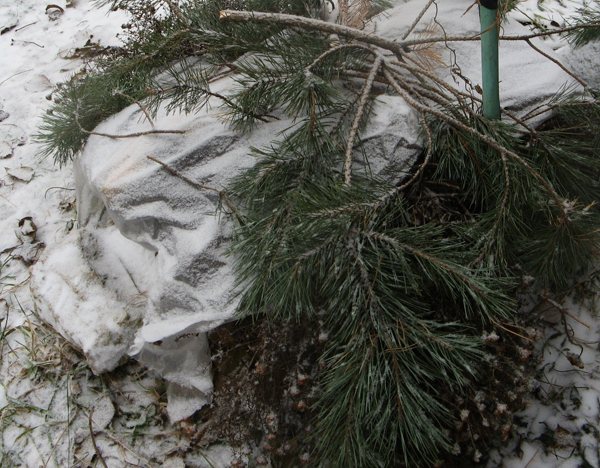

Gardeners who have been growing blackberries on plots for several years have extensive experience in wrapping them up for the winter. Below are some helpful tips.
- Blackberries leave during the dormant period with foliage, you do not need to remove them yourself. The leaves will provide additional insulation for the shoots. In addition, picking foliage by hand can result in damage to the bark of the branches, which will negatively affect the winter hardiness of the bush.
- In order to prevent crust from forming in the upper snow layer during variable thaws and frosts, several stakes are installed.
- Agrofibre is chosen exclusively in white shades. In spring, it will reflect bright sunlight, so the air temperature inside the protective structure will not rise too much.
- In regions with little snow, all kinds of snow retention methods are used. For this, additional material, for example, spruce branches, is laid over the entire protective structure.
- In order for the shelter not to be detrimental to plants, it must be removed in a timely manner and correctly. As the temperature rises, each layer of the structure is gradually removed, the old mulch is raked off to accelerate the heating of the soil. The shoots are straightened and untied, and a few days after that, spring pruning and other care manipulations are carried out.
Why did the vine die after wintering
There are several main reasons here:
- During the thaw, the gardener did not ventilate the bushes, because of this, a greenhouse was formed.The plant turned out to be rotted, as a result of which it died.
- The covering material was not chosen correctly. The air temperature in winter was too low, as a result of which the vine froze.
You can lose the plant even after opening. The culture is thermophilic, in spring it is very susceptible to external negative factors. There are several reasons for the death of the vine after opening:
- Returning frosts. At a temperature of -3 ° C, in conditions of low humidity and wind, young leaves turn black, shoots dry out and become brittle. Fruit buds freeze, and they are the key to a good harvest.
- Spring desiccation. It occurs due to the fact that the root system is in frozen ground, and young shoots need good nutrition. The main reason is dry winds and hot sun rays.

